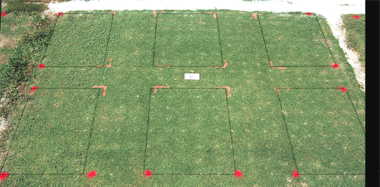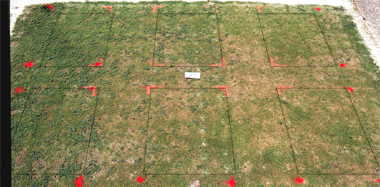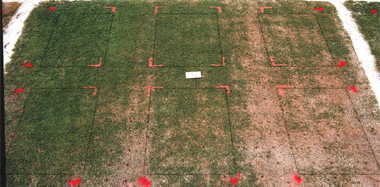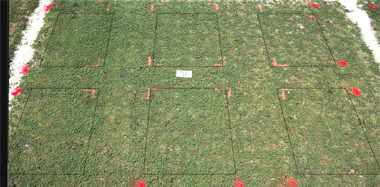|
 |
| The photographs were taken under cloudless conditions the
afternoon of 13 July, using a 35-mm lens, with Kodachrome 64 film, F-stop=11 and 1/125th
of second. Transparencies were scanned to 4-MB TIFF files with a Polaroid Scanner,
and the digital images opened in Adobe PhotoShop, tilted to parallel, brightness-adjusted
+35 units, contrast adjusted to +30 units, uniformly cropped, and sized to 380 pixels
width, and black plot borders added. PhotoShop files were optimized with Ulead
SmartSaver to JPEG quality level 60, no smoothing. |
|
Originated from the USDA-ARS, Coastal Plains
Research Station, in Tifton, Georgia, Tifton, Tifdwarf was discovered as an off-type in
early plantings of 328 (Tifgreen). It was released in 1960 by Dr. Glenn Burton, and
during the last 40 years it has been the mainstay of golf greens in Florida. These
four replicated plots were planted at University of Florida - Fort Lauderdale in May
1997. (See also the 1993 planting). Throughout
most of their evaluation they were mowed at 1/8 inch. Plots were aerified the week
of 21 June 1999 and were treated with excess rates of herbicides 29 June 1999 and again
7July 1999, thus the cumulative rates were actually 2X, 4X, 6X, 8X, and 10X. Mowing
was suspended as soon as treatments began.
Tifdwarf bermudagrass (1997 planting) performed overall: Fair (7.3) |
|
|
| Basagran T/O (top row 0X, 1X, and 2X; bottom row 3X, 4X,
and 5X). Very, very tight dwarf. Uniform. |
 |
|
 |
| Illoxan 3EC (top row 0X, 1X, and 2X; bottom row 3X, 4X,
and 5X). Weak grass. Injuried by herbicide. |
 |
|
 |
| MSMA 6.6 (top row 0X, 1X, and 2X; bottom row 3X, 4X, and
5X). Weak grass. Severely injured by herbicide. |
 |
|
 |
| Primo (top row 0X, 1X, and 2X; bottom row 3X, 4X, and
5X). Weak. |
 |
|
|
|



